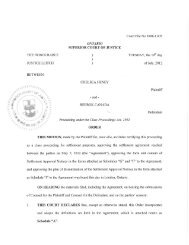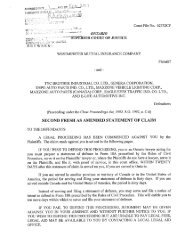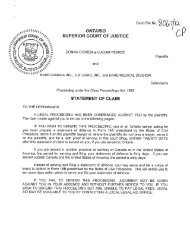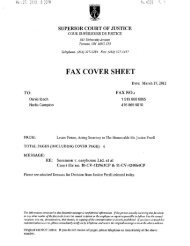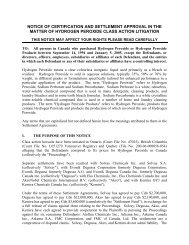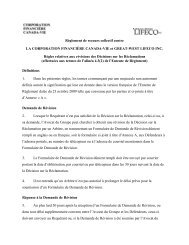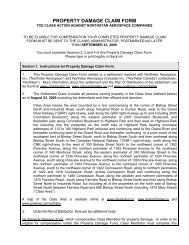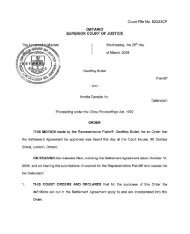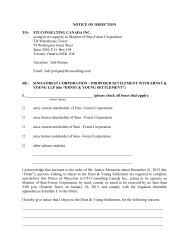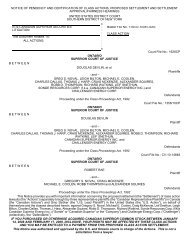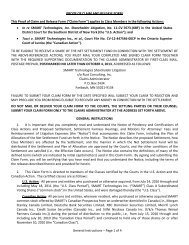Gariepy v. Shell Oil Co. - Classaction.ca
Gariepy v. Shell Oil Co. - Classaction.ca
Gariepy v. Shell Oil Co. - Classaction.ca
Create successful ePaper yourself
Turn your PDF publications into a flip-book with our unique Google optimized e-Paper software.
out of some judgments to date, and it is U.S. where you have focused youreffort, right?A. Yes.258. Q. So what percentage of those 6 million households has had a prematurepolybutylene failure?A. I don't have number in my hands. In the <strong>ca</strong>ses which I examined, which I studied,I notice the failure rate, it means the total failures which exceed 10, 15 percent." 63 These factors distinguish this <strong>ca</strong>se from many other product liability <strong>ca</strong>ses. While the plaintiffsassert that product liability <strong>ca</strong>ses are the "paradigm" for class actions and point to a number of otherproduct liability <strong>ca</strong>ses where certifi<strong>ca</strong>tion has been granted, I do not believe that certifi<strong>ca</strong>tion <strong>ca</strong>nbe determined simply by the genre of the claims advanced. Each <strong>ca</strong>se has to be evaluated on its ownfacts. While I do not intend to review every products liability <strong>ca</strong>se that has so far been consideredfor certifi<strong>ca</strong>tion, I would note, by way of example, that this is not a <strong>ca</strong>se such as Ontario New HomeWarranty Program v. Chevron Chemi<strong>ca</strong>l <strong>Co</strong>. (1999), 46 O.R. (3d) 130 (S.C.J.) where there was anorder by the responsible Provincial Ministry which required all owners of certain furnaces to replacedefective piping made by certain of the defendants. In that <strong>ca</strong>se, which I note in passing was asettlement class certifi<strong>ca</strong>tion, proof of the defect would lead almost immediately to an award ofdamages for the repairs that had to be incurred. The decision in Campbell v. Flexwatt <strong>Co</strong>rp. (1997),15 C.P.C. (4th) 1 (B.C.C.A.) is also distinguishable on the same basis. The decision in Chace v.Crane Canada Inc. (1996), 5 C.P.C. (4th) 292 (B.C.C.A.) differs from this <strong>ca</strong>se on two grounds.First, in Chace the class was narrowly defined to include only those individuals who had "suffereddamages as a result of the cracking of a toilet tank" manufactured by the defendant. Second, thecourt there held that the determination of whether any class member had suffered damage be<strong>ca</strong>useof the defective tank and the quantum of those damages were issues that were likely to be"straightforward". In this <strong>ca</strong>se, as I have already said, the issues left to be determined are far fromstraightforward. Indeed, if similarity between <strong>ca</strong>ses was to be the test for determining certifi<strong>ca</strong>tion,then this <strong>ca</strong>se would appear to be most similar to Bittner v. Louisiana-Pacific <strong>Co</strong>rp., [1997] B.C.J.No. 2281 (S.C.) where certifi<strong>ca</strong>tion was denied. 64 The situation here is also not like a medi<strong>ca</strong>l products liability <strong>ca</strong>se, such as Nantais v.Telectronics Proprietary (Canada) Limited (1995), 25 O.R. (3d) 331 (Gen. Div.) or Endean v.Canadian Red Cross Society (1997), 148 D.L.R. (4th) 158 (B.C.S.C.), where proof of defectivenesswill likely give rise to either a need to remove the product or otherwise provide treatment or, at thevery least, a need to monitor the performance of the product such that, again, immediate damage isoc<strong>ca</strong>sioned to all members of the class. 65 In this <strong>ca</strong>se, first and foremost, it is not clear that there will be a single answer to the scientificquestion given the variety of factors which <strong>ca</strong>n impact on the alleged reasons why the products may



